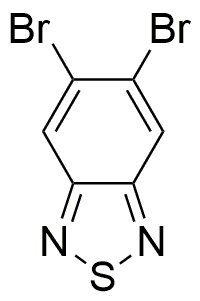5,6-Dibromo-2,1,3-benzothiadiazole is widely utilized in research focused on:
- Organic Electronics: This compound is used in the development of organic semiconductors, which are essential for creating flexible and lightweight electronic devices like organic light-emitting diodes (OLEDs) and organic solar cells.
- Fluorescent Dyes: It serves as a precursor for synthesizing fluorescent dyes, which are crucial in biological imaging and diagnostics, allowing researchers to visualize cellular processes with high precision.
- Corrosion Inhibitors: The compound is applied in formulating corrosion inhibitors for metals, enhancing the longevity and durability of industrial equipment in sectors like oil and gas.
- Pharmaceuticals: It plays a role in drug development, particularly in creating compounds that target specific biological pathways, thus aiding in the design of new therapeutic agents.
- Environmental Monitoring: This chemical is used in sensors for detecting pollutants, providing a vital tool for environmental scientists to monitor and manage contamination levels in water and soil.
General Information
Properties
Safety and Regulations
Applications
5,6-Dibromo-2,1,3-benzothiadiazole is widely utilized in research focused on:
- Organic Electronics: This compound is used in the development of organic semiconductors, which are essential for creating flexible and lightweight electronic devices like organic light-emitting diodes (OLEDs) and organic solar cells.
- Fluorescent Dyes: It serves as a precursor for synthesizing fluorescent dyes, which are crucial in biological imaging and diagnostics, allowing researchers to visualize cellular processes with high precision.
- Corrosion Inhibitors: The compound is applied in formulating corrosion inhibitors for metals, enhancing the longevity and durability of industrial equipment in sectors like oil and gas.
- Pharmaceuticals: It plays a role in drug development, particularly in creating compounds that target specific biological pathways, thus aiding in the design of new therapeutic agents.
- Environmental Monitoring: This chemical is used in sensors for detecting pollutants, providing a vital tool for environmental scientists to monitor and manage contamination levels in water and soil.
Documents
Safety Data Sheets (SDS)
The SDS provides comprehensive safety information on handling, storage, and disposal of the product.
Product Specification (PS)
The PS provides a comprehensive breakdown of the product’s properties, including chemical composition, physical state, purity, and storage requirements. It also details acceptable quality ranges and the product's intended applications.
Certificates of Analysis (COA)
Search for Certificates of Analysis (COA) by entering the products Lot Number. Lot and Batch Numbers can be found on a product’s label following the words ‘Lot’ or ‘Batch’.
Numéro de catalogue
Numéro de lot/série
Certificates Of Origin (COO)
This COO confirms the country where the product was manufactured, and also details the materials and components used in it and whether it is derived from natural, synthetic, or other specific sources. This certificate may be required for customs, trade, and regulatory compliance.
Numéro de catalogue
Numéro de lot/série
Safety Data Sheets (SDS)
The SDS provides comprehensive safety information on handling, storage, and disposal of the product.
DownloadProduct Specification (PS)
The PS provides a comprehensive breakdown of the product’s properties, including chemical composition, physical state, purity, and storage requirements. It also details acceptable quality ranges and the product's intended applications.
DownloadCertificates of Analysis (COA)
Search for Certificates of Analysis (COA) by entering the products Lot Number. Lot and Batch Numbers can be found on a product’s label following the words ‘Lot’ or ‘Batch’.
Numéro de catalogue
Numéro de lot/série
Certificates Of Origin (COO)
This COO confirms the country where the product was manufactured, and also details the materials and components used in it and whether it is derived from natural, synthetic, or other specific sources. This certificate may be required for customs, trade, and regulatory compliance.


